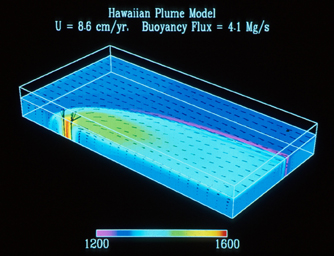Course Outline
Course Outline
1. Background on Tectonics and Mantle Convection
– How do plumes and ridges fit into ideas regarding mantle convection
– What is a plume, how are they distributed around the globe?
– How do the properties of plumes and ridges vary?
– What would be a canonical model for the chronology of a p/r interaction?
– What are the burning, unanswered questions regarding plumes, ridges,
and p/r interactions?
– What kinds of data and modeling are needed to answere the important
questions?
2. Case Study 1: Iceland/Northern MAR – Stuck in the middle?
– What is the pattern of mantle flow beneath Iceland?
– How big is the Iceland plume? Where is it?
– How far downrift can the chemical and mechanical influence of
the Iceland plume be traced?
– How and where is the plume fragmented and distributed to discrete
volcanic systems?
– What is the role of the Iceland plume in the early stages of rifting
on the northern MAR?
– What do the V-shaped ridges tell us about the p/r interaction
and its influence on parameters such as lithospheric strength and
upper mantle flow?
3. Case Study 2: Galapagos/GSC – Gone but not forgotten.
– How has the interaction between the Galapagos plume and the Galapagos
Spreading Center evolved over time?
– How does lava chemistry vary along the GSC and what does this
imply regarding the p/r interaction?
– What is the present pattern of mantle flow beneath this system?
-What does the mantle matrix do between the two upwelling features?
– Is there still a melt connection?
– How big is the Galapagos plume? Where is it?
4. Case Study 3: Cobb/JdFR – The first days are the hardest
days.
– Is the Cobb hotspot a plume?
– How has it behaved in the hot-spot reference frame?
– Does it have a geochemical signature?
– Where is it presently located?
– How deep is it rooted?
– What is the pattern of mantle flow beneath this system?
– When did the JdFR start bending towards the Cobb hotspot?
– How is melt distributed beneath the central JdFR?
– How does lava chemistry vary along the JdFR/Cobb region?
– What patterns of matrix and melt flow are consistent with the
observational and theoretical constraints?
– How might long-term observatories, such as NeMO and Neptune contribute
to our understanding of the p/r interaction?
5. Esoterica
– How do ridges, plumes, and p/r interactions influence the global
biogeography of chemosynthetic systems?
– How do the myriad millions of near-ridge seamounts relate to p/r
interactions?
– How fixed is the hot spot reference frame?
– Can large plumes create new plate boundaries?
– How deep is the source region for hotspots?

Numerical model of the Hawaiian Plume (from Ribe and Christensen, JGR Vol. 99, pp. 669-682, 1994.)